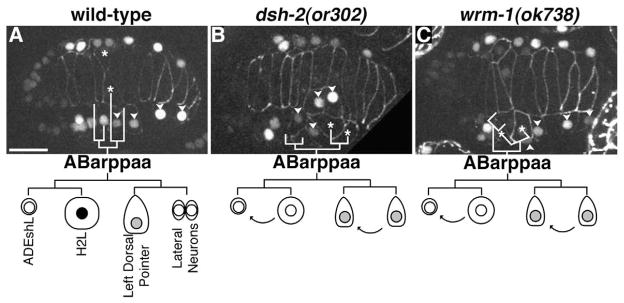Fig. 3.

dsh-2 and Wnt/β-catenin asymmetry pathway mutants display asymmetric hypodermal lineage defects. (A–C) Dorsal views of embryos expressing CEH-16::GFP (nuclei) and AJM-1::GFP (cell borders). (A) Wild-type embryo. ABarppaa gives rise to (from anterior to posterior) the anterior deirid (ADEshL), a lateral (seam) cell (H2L), the left dorsal pointer cell, and a neuroblast. Only H2L retains strong expression of CEH-16::GFP (black nucleus in the schematic). (B) Embryo from dsh-2(or302) mutant mother. CEH-16::GFP levels become quickly diminished in all ABarppaa progeny. ABarppaap divides symmetrically, forming two dorsal pointer cells. (C) wrm-1(ok738) mutant embryo. ABarppaaa divides asymmetrically, but the larger posterior cell loses CEH-16::GFP expression and behaves like a second ADEshL. ABarppaap divides symmetrically, giving rise to two dorsal pointer cells. Asterisks = dorsal pointer cells; arrowheads = ABarppap derived seam cells. Scale bar=10 μm.
